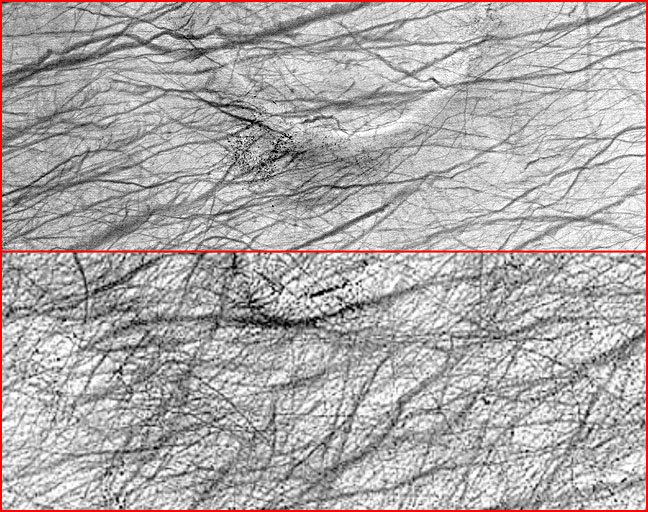
home •
about •
essential guide •
picture of the day •
thunderblogs •
news •
multimedia •
predictions •
products •
get involved •
contact

Credit: NASA/JPL
pic of the day
archive
subject index
abstract
archive
Links:
Society for
Interdisciplinary
Studies
Mar 18, 2005
Europa and Mars
Giant “dust devils” on Mars offer compelling clues as to the true cause of the rille networks on Europa.
Perhaps readers who have followed our discussion of “electric discharge channels” on Jupiter’s moon Europa will recognize the bizarre landscape in the pictures above. Can you identify which picture is of the Europan surface?
The upper picture is of particular interest because it shows how the force that created the linear streaks was oblivious to other landscape features. As observed by the electrical theorists, this is one of the unsolved mysteries of rilles seen on many different bodies in the solar system.
The lower picture is also of special interest. For one thing, it is reminiscent of the intimate connection between rille creation and unusual cratering or etching patterns on planets, moons, and asteroids. Note that many of the streaks appear to be little more than chains of dark spots or dots, a pattern reminding us that many rilles are little more than extended crater chains. Prior theoretical assumptions have prevented planetary scientists from either noticing the repeated pattern, or accounting for it.
So here is the punchline. Neither picture above is of Europa, though the streaks look almost exactly like the channel complexes on Europa. For comparison with Europa, we’ve placed a good picture of Jupiter’s moon here.
Actually, both pictures above depict regional landscapes on the planet Mars, where towering “dust devils” have wandered across the surface, leaving telltale tracks behind them. Investigators have been astonished at the “electrical power” of these Everest-sized vortices eroding the surface of Mars. Since the atmosphere of Mars is only one percent of the Earth’s, it is certainly not wind alone that is producing these effects on Mars! Indeed, the experts have struggled to find a way for Martian “air” to move the surface soil at all. (See our next Picture of the Day—“Electric Tornadoes on Mars”—for further discussion of these mysteries).
The
similarities extend beyond the Europan rilles and surface
“scratches” on Mars to other common features and contexts. In
neither instance could the pits, dimples, or darkened
spots—often centered upon the linear impressions—be impact craters.
Most show a generally constant size. But electric arcing is known to
produce such crater patterns, including even the darkening of the
surface where it occurs. See Picture of the Day for November 30,
2004—Craters on Mars
and for
July 2,2004—Craters
in the Lab
On both Mars
and Europa we see a combination of darker and lighter
marks in relation to the landscape on which they appear. (The
contrasting lighter “dust devil” tracks on Mars can be seen
here.)
This common
feature, as we shall note in tomorrow’s Picture of the Day, is
readily explained electrically. The
comparison of Europan channels and Martian “dust devil” tracks can
only underscore the new possibilities introduced by the electrical
hypothesis. And when it comes to the planet Mars, the applications
are virtually limitless.
EXECUTIVE EDITORS:
David Talbott, Wallace Thornhill
MANAGING EDITOR: Amy Acheson
CONTRIBUTING EDITORS: Mel Acheson, Michael Armstrong, Dwardu Cardona,
Ev Cochrane, C.J. Ransom, Don Scott, Rens van der Sluijs, Ian Tresman
WEBMASTER: Michael Armstrong
Copyright 2005: thunderbolts.info